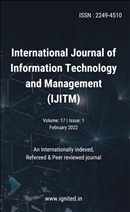Juvenile Delinquency and Recidivism: An Overview
Main Article Content
Authors
Abstract
Recidivism in juveniles is a legal notion in criminal law. Juvenile refers to someone under theage of 18 the definition of an adult varies from nation to nation. In India, the Juvenile Justice Actmandates that juveniles convicted of misdemeanors be housed in institutions that offer therapeutic,educational, and vocational programs.The presence of a criminal milieu has influenced many young people to turn to criminal activity as ameans of self-expression. In this paper, we discuss two variables that contribute to juvenile recidivism.Firstly, in the adolescent population, a lack of parental oversight contributes to criminalmisbehaviour. Juvenile recidivism is fueled by peer pressure. Teenagers who are unemployed or earninglow wages are more likely to commit crimes. Secondly, mental health of juveniles is also a hot topicinternationally. Suicidal thoughts and behaviours are exacerbated by mental health issues. Depressiveillnesses, juvenile detention, and other societal issues combine to create a climate where youth rush toterminate their lives.In light of the 2012 Delhi rape case and after much debate, intensive conversation, and demonstrations,Indian Parliament enacted the Juvenile Justice (Care and Protection of Children) Act 2015. The authorhas explained that howjuveniles can now be disciplined using new methodsunder new legislation andadequately implementing existing ones.
Downloads
Download data is not yet available.
Article Details
Section
Articles
References
- Juvenile Justice (Care And Protection of Children) Act, 2000 https://indiankanoon.org/doc/148942/
- juvenile’, https://dictionary.cambridge.org/dictionary/english/juvenile
- Word of the Day: Recidivism - Merriam-Webster. Word of the Day: Recidivism | Merriam-Webster
- National Institute of Justice (NIJ) https://nij.ojp.gov/topics/corrections/recidivism#:~:text=It%20refers%20to%20a%20person's,intervention%20for%20a%20previous%20crime.&text=Specific%20deterrence%20is%20the%20terminology,has%20been%20imposed%20or%20completed.
- Max Schlenker, SOCHUM II: Juvenile Deliquency Around the World, YMUN Taiwan, SOCHUM II: Juvenile Delinquency Around the World — Shorthand Social
- Priyanka Navalkar, Maharashtra observes high recidivism in juveniles in conflict with law, The Free Press Journal, February 10, 2020, https://www.freepressjournal.in/mumbai/maharashtra-observes-high-recidivism-in-juveniles-in-conflict-with-law
- Fact Sheet on Juvenile Justice, United Nations Fact Sheets on Youth, https://www.un.org/esa/socdev/unyin/documents/wyr11/FactSheetonYouthandJuvenileJustice.pdf
- Vieno et. al., ‘Parenting and antisocial behavior: a model of the relationship between adolescent self-disclosure, parental closeness, parental control, and adolescent antisocial behavior’, Developmental Psychology, 45(6), 1509–1519, 1 November 2009, https://doi.org/10.1037/a0016929
- Gottfredson, M. R., & Hirschi, A General Theory of Crime, Stanford University Press, 1990.
- Hoeve et al , The relationship between parenting and delinquency: a meta-analysis. J Abnorm Child Psychol. 2009 Aug;37(6):749-75. doi: 10.1007/s10802-009-9310-8. PMID: 19263213; PMCID: PMC2708328.
- Juvenile Crime and Substance Abuse, Child Crime Prevention & Safety Centre, https://childsafety.losangelescriminallawyer.pro/juvenile-crime-and-substance-abuse.html
- Krezmien, Michael P., et al. “Detained and Committed Youth: Examining Differences in Achievement, Mental Health Needs, and Special Education Status.” Education and Treatment of Children, vol. 31, no. 4, 2008, pp. 445–64, http://www.jstor.org/stable/42899991.
- Shaw and McKay, Social Disorganization Theory, Sociology. DOI: 10.1093/obo/9780199756384-0192
- David Altschuler et.al., Supporting Youth in Transition to Adulthood: Lessons Learned from Child Welfare and Juvenile Justice’, Center for Juvenile Justice Reform and Jim Casey Youth Opportunities Initiative, April 2009, Supporting Youth in Transition to Adulthood: Lessons Learned from Child Welfare and Juvenile Justice - CORE
- Chapter 7 Juvenile Delinquency, World Youth Report, 2003, pg. 194, https://www.un.org/esa/socdev/unyin/documents/ch07.pdf
- Vincent GM, Grisso T, Terry A, Banks S. Sex and race differences in mental health symptoms in juvenile justice: the MAYSI-2 national meta-analysis. J Am Acad Child Adolesc Psychiatry. 2008 Mar;47(3):282-290. DOI: 10.1097/CHI.0b013e318160d516. PMID: 18216730.
- Gail Wasserman and Larkin Mcreynolds, The Contribution of Psychiatric Disorder to Juvenile Recidivism, Criminal Justice and Behavior, January 4, 2010, DOI: https://doi.org/10.1177/0093854809354961
- Joseph J. Cocozza and Kathy Skowyra, Youth with Mental Health Disorders: Issues and Emerging Responses, Juvenile Justice, Journal of the Office of Juvenile Justice and Delinquency Prevention, Vol. VII, No.1, Pg. 3, https://www.ojp.gov/pdffiles1/ojjdp/178256.pdf
- Wald J, Losen DJ. Defining and redirecting a school-to-prison pipeline. New Dir Youth Dev. 2003 Fall;(99):9-15. DOI: 10.1002/yd.51. PMID: 14635431.
- Teplin LA, Abram KM, McClelland GM, Dulcan MK, Mericle AA. Psychiatric disorders in youth in juvenile detention. Arch Gen Psychiatry. 2002 Dec;59(12):1133-43. DOI: 10.1001/archpsyc.59.12.1133. PMID: 12470130; PMCID: PMC2861992.
- Abram KM, Teplin LA, McClelland GM, Dulcan MK. Comorbid psychiatric disorders in youth in juvenile detention. Arch Gen Psychiatry. 2003 Nov;60(11):1097-108. DOI: 10.1001/archpsyc.60.11.1097. PMID: 14609885; PMCID: PMC2893728.
- National Action Alliance for Suicide Prevention, 2013, Health Care | National Action Alliance for Suicide Prevention (theactionalliance.org)
- Wasserman, McReynolds, Schwalbe, Keating, & Jones, Psychiatric Disorder, Comorbidity, and Suicidal Behavior in Juvenile Justice Youth, Criminal Justice and Behavior, November 2010, 37(12):1361-1376, DOI:10.1177/0093854810382751
- Children Behind Bars - The Global Overuse of Detention of Children, Human Rights Watch, https://www.hrw.org/world-report/2016/country-chapters/africa-americas-asia-europe/central-asia-middle-east/north#
- Life Imprisonment, Child Rights International Network (CRIN), https://archive.crin.org/en/home/campaigns/inhuman-sentencing/life-imprisonment.html
- Death Penalty,Child Rights International Network (CRIN), https://archive.crin.org/en/home/campaigns/inhuman-sentencing/problem/death-penalty.html
- MST Services, ‘Do We Know the Full Extent of Juvenile Recidivism?’, Nov 1, 2018, https://info.mstservices.com/blog/juvenile-recidivism-rates
- The Juvenile Justice (Care and Protection of Children) Act, 2015
- Parliamentary Standing Committee on Human Resource Development, 264th Report, pg. 15, 25th February, 2015
- Rashme Sehgal, Does the Juvenile Justice Act Need Amendment, Rediff news, July 28, 2014, https://www.rediff.com/news/column/does-the-juvenile-justice-act-need-amendment/20140728.htm
- Shalini Nair, The Many Heinous Crimes that make a Juvenile an Adult, The Indian Express, December 25, 2015, https://indianexpress.com/article/explained/the-many-heinous-crimes-that-make-a-juvenile-an-adult/

